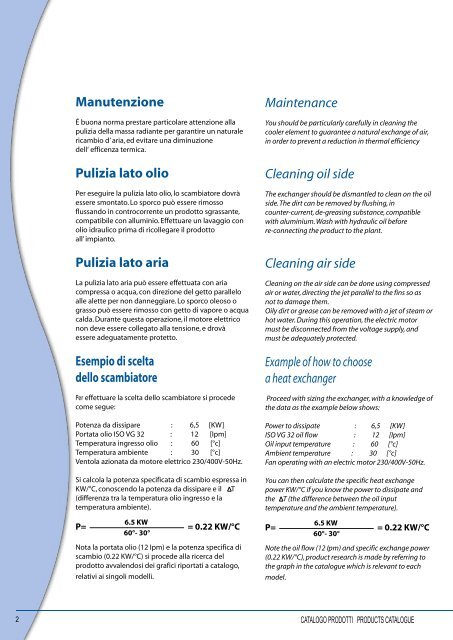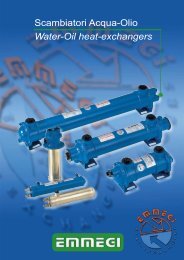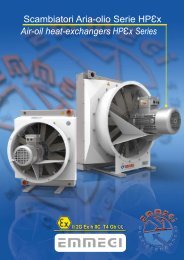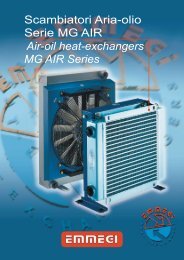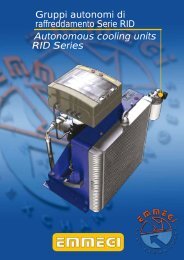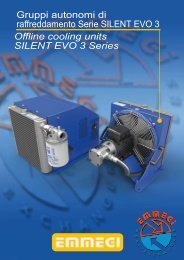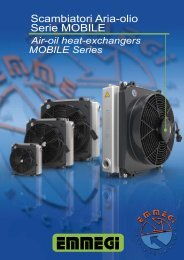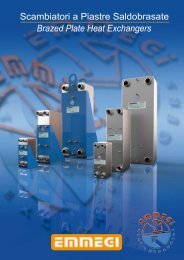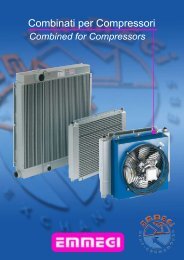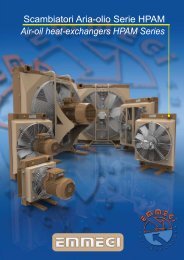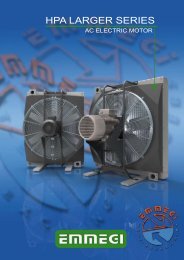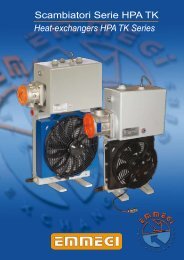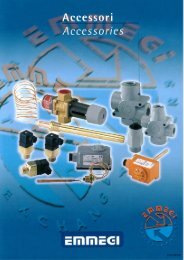3 - Scambiatori Aria-olio Serie DRAIN 2000K
Create successful ePaper yourself
Turn your PDF publications into a flip-book with our unique Google optimized e-Paper software.
Manutenzione<br />
É buona norma prestare particolare attenzione alla<br />
pulizia della massa radiante per garantire un naturale<br />
ricambio d’ aria, ed evitare una diminuzione<br />
dell‘ efficenza termica.<br />
Pulizia lato <strong>olio</strong><br />
Per eseguire la pulizia lato <strong>olio</strong>, lo scambiatore dovrà<br />
essere smontato. Lo sporco può essere rimosso<br />
flussando in controcorrente un prodotto sgrassante,<br />
compatibile con alluminio. Effettuare un lavaggio con<br />
<strong>olio</strong> idraulico prima di ricollegare il prodotto<br />
all’ impianto.<br />
Pulizia lato aria<br />
La pulizia lato aria può essere effettuata con aria<br />
compressa o acqua, con direzione del getto parallelo<br />
alle alette per non danneggiare. Lo sporco oleoso o<br />
grasso può essere rimosso con getto di vapore o acqua<br />
calda. Durante questa operazione, il motore elettrico<br />
non deve essere collegato alla tensione, e drovà<br />
essere adeguatamente protetto.<br />
Esempio di scelta<br />
dello scambiatore<br />
Per effettuare la scelta dello scambiatore si procede<br />
come segue:<br />
Potenza da dissipare : 6,5 [KW]<br />
Portata <strong>olio</strong> ISO VG 32 : 12 [Ipm]<br />
Temperatura ingresso <strong>olio</strong> : 60 [°c]<br />
Temperatura ambiente : 30 [°c]<br />
Ventola azionata da motore elettrico 230/400V-50Hz.<br />
Si calcola la potenza specificata di scambio espressa in<br />
KW/°C, conoscendo la potenza da dissipare e il T<br />
(differenza tra la temperatura <strong>olio</strong> ingresso e la<br />
temperatura ambiente).<br />
6.5 KW<br />
P= = 0.22 KW/°C<br />
60°- 30°<br />
Nota la portata <strong>olio</strong> (12 Ipm) e la potenza specifica di<br />
scambio (0.22 KW/°C) si procede alla ricerca del<br />
prodotto avvalendosi dei grafici riportati a catalogo,<br />
relativi ai singoli modelli.<br />
Maintenance<br />
You should be particularly carefully in cleaning the<br />
cooler element to guarantee a natural exchange of air,<br />
in order to prevent a reduction in thermal efficiency<br />
Cleaning oil side<br />
The exchanger should be dismantled to clean on the oil<br />
side. The dirt can be removed by flushing, in<br />
counter-current, de-greasing substance, compatible<br />
with aluminium. Wash with hydraulic oil before<br />
re-connecting the product to the plant.<br />
Cleaning air side<br />
Cleaning on the air side can be done using compressed<br />
air or water, directing the jet parallel to the fins so as<br />
not to damage them.<br />
Oily dirt or grease can be removed with a jet of steam or<br />
hot water. During this operation, the electric motor<br />
must be disconnected from the voltage supply, and<br />
must be adequately protected.<br />
Example of how to choose<br />
a heat exchanger<br />
Proceed with sizing the exchanger, with a knowledge of<br />
the data as the example below shows:<br />
Power to dissipate : 6,5 [KW]<br />
ISO VG 32 oil flow : 12 [Ipm]<br />
Oil input temperature : 60 [°c]<br />
Ambient temperature : 30 [°c]<br />
Fan operating with an electric motor 230/400V-50Hz.<br />
You can then calculate the specific heat exchange<br />
power KW/°C if you know the power to dissipate and<br />
the T (the difference between the oil input<br />
temperature and the ambient temperature).<br />
6.5 KW<br />
P= = 0.22 KW/°C<br />
60°- 30°<br />
Note the oil flow (12 Ipm) and specific exchange power<br />
(0.22 KW/°C), product research is made by referring to<br />
the graph in the catalogue which is relevant to each<br />
model.<br />
2 CATALOGO PRODOTTI PRODUCTS CATALOGUE


